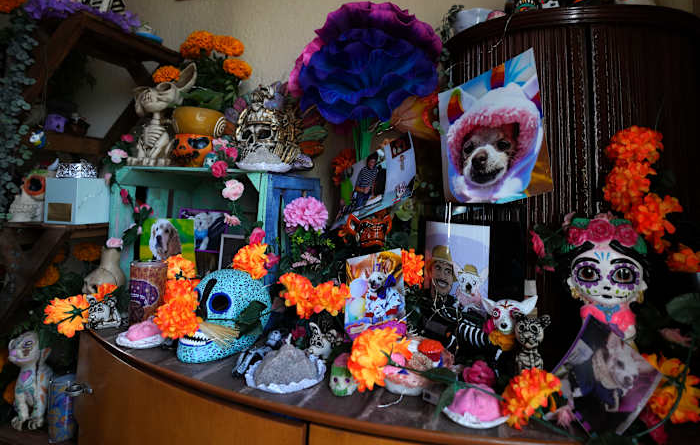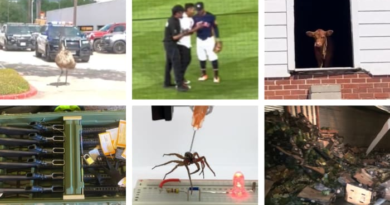Pets join Mexico's Day of the Dead celebrations, as Fido and Tiger get their own altars – WPLG Local 10
BREAKING NEWS
Fabiola Sánchez
Associated Press
Published:
Fabiola Sánchez
Associated Press
Copyright 2024 The Associated Press. All rights reserved.
A Day of the Dead altar celebrating the memory of Taco, Meztli Lizaola’s pet Chihuahua, sits on a wooden piece of furniture, installed in a corner of her living room in Mexico City, Wednesday, Oct. 30, 2024. (AP Photo/Fernando Llano)
MEXICO CITY – Pets are not forgotten during Mexico’s famed Day of the Dead celebrations, when even Fido and Tiger get a place at the altars Mexican families set up to honor their deceased loved ones, complete with flowers, candles and photographs.
Though the human dead usually get their favorite food or drink placed on altars, the nature of pet food can make things a little different.
Recommended Videos
The holiday has roots in Mexican pre-Hispanic customs, as does the reverence for animals. The small, hairless dogs that Mexicans kept before the Spanish conquest were believed to help guide their owners to the afterlife, and were sometimes given special burials.
But the inclusion of pets on family altars has grown in recent years.
Day of the Dead begins Oct. 31, to remember those humans who died in accidents; it continues Nov. 1 to mark those who died in childhood and then Nov. 2 to those who died as adults.
Observances include entire families cleaning and decorating graves, which are covered with orange marigolds. At both cemeteries and at home altars, relatives light candles, put out offerings of the favorite foods and beverages of their deceased relatives.
The presence of pets has gained such momentum that now Oct. 27 is considered Day of the Dead for pets and the National Anthropology and History Institute includes tips on its social platforms for how to include them in altars.
Mexico City graphic designer Meztli Lizaola makes sure every year that her beloved tawny-coated Chihuahua, Taco — who died two years ago — has a place at the altar on a table in the corner of her living room.
Taco’s ashes are there in an urn, and so is his lively-eyed photo, next to a photo of Lizaola’s deceased father.
The orange-flowered cempasúchil — a type of marigold — is placed around the photos, as well as candles and figurines of skulls.
Taco was an omnivorous eater and — as his name suggests — enjoyed tacos (especially roast pork) and other traditional Mexican human foods like quesadillas and concha pastries.
But because she has four other dogs, she can’t leave Taco’s favorite foods on the altar; some sneaky pup is likely to snatch it.
For years now, elements of Halloween have been mixing into the seasonal festivities, and for pets it’s no different. For those who still have living dogs and cats, it is not uncommon to find a wide variety of pet Halloween costumes at pet shops, including inmate-style “bad dog” costumes.
Ethnohistorian Juan Pablo García Urióstegui says the inclusion of pets and Halloween influences are part of changes in the traditional holiday that have accelerated, particularly in the last three years,
“We are experiencing changes in the traditions. It is happening very fast,” said García Urióstegui, of Mexico’s National Anthropology Museum. Now it’s not unusual to find pets on airplanes, in bars and restaurants or even at their owners’ medical appointments.
For one thing, especially in big cities, the large family of numerous children is often a thing of the past, and couples having only pets — dubbed “perrihijos” or “dog kids” — are now not uncommon.
“That’s where you see these practices concerning death starting to take hold,” he said. “They are no longer just another companion … they are living beings who hold memories, and whose memory must be commemorated.”
But the admiration for dogs goes way back in Mexico, where hairless dogs known as xoloitzcuintles were common before the Spanish brought their larger, furrier hounds to Mexico during the 1519-1521 conquest.
The pre-Hispanic dogs were often sacrificed or buried near their owners — or represented as carefully crafted ceramic figurines — because the owner would need the dogs’ keen senses to find the path to the underworld after death.
Lizaola still feels Taco’s absence. His face is tattooed on her right arm. The dog changed her life and that of her partner.
“There’s like a before and after in my life,” she said, noting that Taco inspired them to get more involved in supporting abandoned animals and rescuing dogs from the street.
Initially, there was some resistance within her family to including Taco on the altar, a place long reserved for departed family members. But as relatives’ pets died they came around and “now it’s more dogs than humans,” she said.
Copyright 2024 The Associated Press. All rights reserved. This material may not be published, broadcast, rewritten or redistributed without permission.
Recommended Videos
TV Listings
Email Newsletters
RSS Feeds
Closed Captioning / Audio Description
Contact Us
Careers at WPLG
Terms of Use
Privacy Policy
Public File
FCC Applications
EEO Report
Do Not Sell My Info
1.0 Host Exhibit
If you need help with the Public File, call (954) 364-2526.
Copyright © 2024 Local10.com is published by WPLG INC., a Berkshire Hathaway company.



